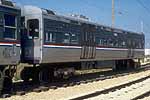
|
cta6656d.jpg
6000-series car 6656
next its mate, 6655, at the Illinois
Railway Museum on August 8, 2001. They are not, however,
connected together at their #2 ends as usual; car 6655's
front (#1) end -- denoted by the Spirit of Chicago emblem
below the motorcab window -- is sitting against 6656's rear
(#2) end. (Photo by Mike Farrell) |
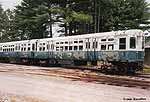
|
cta6599-6600.jpg
Cars 6599-6600, looking a bit wary in faded and peeling
paint, sit on display location in front of the Highwood
Exhibit Barn at the Seashore
Trolley Museum in Kennebunkport, Maine in July 2001.
Seashore is unlikely to consider bringing the units up to
operating condition as there are many, higher priority
projects on their long list of rolling stock.
(Photo by Ernie Baudler) |
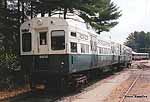
|
cta6600c.jpg
Except for the distressed exterior paint, car 6600 is
largely as it was the day it was retired in the early 1990s.
It sits at the Seashore
Trolley Museum in July 2001; visible in the far
background, to the right, is the FTA's SOAC
unit. (Photo by Ernie Baudler) |
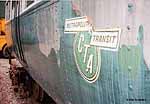
|
cta6600d.jpg
A close up of the side of car 6600, looking towards the
#1 end, showing the gleaming aluminum underneath the peeling
paint and the faded but still appealing "Metropolitan
Transit" CTA shield
logo decal. (Photo by Ernie
Baudler) |

|
cta6600e.jpg
A view of car 6600's anti-climber and coupler, with the
yellow panel that protects the spring-loaded pins in the
electrical coupler in the open position. The first 6000s
did not come with the covers as delivered; they were added
after their first winter in service after snow and ice was
found to disrupt the electrical contact between car.
(Photo by Ernie Baudler) |
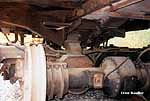
|
cta6600f.jpg
Looking underneath car 6600 gives a look at the unit's
truck assembly. The view is from the center looking under
the #1 end. (Photo by Ernie
Baudler) |
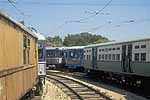
|
ctaS-373etal.jpg
Service car S-373 is seen in Illinois
Railway Museum Yard 8, the museum's "Skokie Shops,"
along with (l to r) 5-50
series cars 30 (with pantograph) and 22, 2000-series
car 2154 and 6000-series
car 6461 on August 8, 2001. (Photo by Mike
Farrell) |

|
cta1-50s_6000s.jpg
(60k)
This Evanston Express train, entering the Lake leg of the
Loop through Tower
18, is diverse in both stock and aesthetics: a 5-50
series car leads at least two 6000s
as it begins its circuit around the Loop before returning to
Evanston in July 1988. (Photo by James
Raymond) |
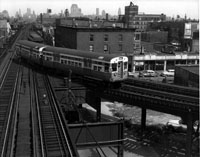
|
cta6000s@PaulinaJct.jpg
(96k)
For just over four years while the new Congress Line was
being constructed, Douglas trains were diverted via the Lake
Street Line to gain access to the Loop. They used a portion
of the Metropolitan's old Northwest branch, previously used
by Logan Square
services, and a new connection to the Lake Line built at
Paulina east of Lake
Street Transfer station. In this 1954 view, a Douglas
train of 6000s turns south
from Lake Street at Paulina Junction on their way out to
Cicero-Berwyn
Terminal. (Photo from the Chicago
Transit Authority Collection) |
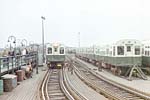
|
cta6511b.jpg
(109k)
The cars in the 6511-6720 series were a fixture on the
West-Northwest Route from 1962 until the mid-80s. In this
undated view at Logan
Square Yard, several of these cars are shown, including
a few still in green, cream and orange paint. Cars in this
older scheme operated into the era of the Kennedy Extension.
(Photo from the Mike Farrell
collection) |









